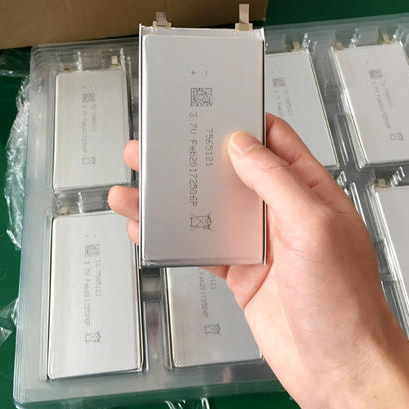
{"img":"","passBy":"0","picBd":"0","size":"1","bdSize":"1","cwidth":227,"cheight":77,"picBdRadio":"0","borderType":"solid","jump":"0","definedUrl":"","isPicBd":"0","effectBdLine":"solid","image":"http://oss.xinghuo86.cn/580494844493902/635479619797080.webp","picWidth":227,"picHeight":77,"inpColor":"#000000","color":"#000000","type":0,"effectBdColor":"#000000","hasEdit":true}
Dongguan Lisen power Co., Ltd.
Add:3rd Floor, Building 2, No. 6, Huangjiang Bei'an 1st Road, Huangjiang Town, Dongguan City.
Te:0769- 82698726
Fax:0769-82698727
E-mail:sales@lisenpower.com
|
Product DetailPolymer battery pack  
Polymer battery is also called lithium polymer battery (Li-polymer), also called polymer lithium battery. It is also a kind of lithium ion battery, but compared with liquid lithium battery (Li-ion), it has many obvious advantages such as high energy density, smaller size, ultra-thin, lightweight, and high safety. New battery. In terms of shape, lithium polymer batteries have ultra-thin features, and can be made into batteries of any shape and capacity to meet the needs of various products. The minimum thickness that this type of battery can reach can reach 0.5mm. Its nominal voltage is the same as Li-ion's nominal voltage of 3.7V, without memory effect.
According to different electrolyte materials used in lithium ion batteries, lithium ion batteries can be divided into two categories: liquid lithium ion batteries (LIB) and polymer lithium ion batteries (LIP). The positive and negative materials used in polymer lithium-ion batteries are the same as liquid lithium ions, and the working principles of the batteries are basically the same. The main difference between them lies in the difference in electrolytes. Li-ion batteries use liquid electrolytes, while polymer lithium-ion batteries use colloidal polymer electrolytes instead.
Advantages of polymer batteries: 1. Ultra-thin, the battery can be assembled into a credit card; 2. Flexible appearance: The manufacturer is not limited to the standard appearance, and can be economically made into a suitable size; 3. Light weight: The battery using polymer electrolyte does not need a metal shell as a protective outer packaging.
Introduction to Lithium Ion Square Battery Lithium ion battery is a kind of secondary battery (rechargeable battery), which mainly relies on the movement of lithium ions between the positive and negative electrodes to work. During the charging and discharging process, Li+ intercalates and deintercalates back and forth between the two electrodes: during charging, Li+ deintercalates from the positive electrode and inserts into the negative electrode through the electrolyte, and the negative electrode is in a lithium-rich state; the opposite is true during discharge.
Lithium batteries are divided into lithium batteries and lithium ion batteries. Cell phones and laptops use lithium-ion batteries, which are commonly known as lithium batteries. Batteries generally use materials containing lithium as electrodes, which are representative of modern high-performance batteries. The real lithium battery is rarely used in daily electronic products due to its high risk.
Lithium-ion batteries were first successfully developed by Sony Corporation of Japan in 1990. It embeds lithium ions into carbon (petroleum coke and graphite) to form a negative electrode (traditional lithium batteries use lithium or lithium alloy as the negative electrode). LixCoO2 is commonly used as the cathode material, and LixNiO2, and LixMnO4 are also used. The electrolyte uses LiPF6 + diethylene carbonate (EC) + dimethyl carbonate (DMC).
Petroleum coke and graphite are non-toxic materials for the negative electrode, and the resources are sufficient. Lithium ions are embedded in the carbon, which overcomes the high activity of lithium and solves the safety problems of traditional lithium batteries. The positive electrode LixCoO2 can reach the charge and discharge performance and life. The higher level reduces the cost, and in short, the overall performance of the lithium-ion battery is improved. It is expected that lithium-ion batteries will occupy a large market in the 21st century.
The reaction formula for charging and discharging lithium ion secondary batteries is LiCoO2+C=Li1-xCoO2+LixC [2]
Advantages of lithium ion battery: 1) High voltage The working voltage of single battery is as high as 3.7-3.8V (3.2V for lithium iron phosphate), which is 3 times that of Ni-Cd and Ni-MH batteries.
2) Greater than energy The actual specific energy that can be achieved is about 555Wh/kg, that is, the material can reach a specific capacity of 150mAh/g or more (3--4 times Ni-Cd, 2--3 times Ni-MH), which is close to its theory. About 88% of the value.
3) Long cycle life Generally, it can reach more than 500 times, or even more than 1000 times, and it can reach 8000 times for lithium iron phosphate. For electrical appliances with low current discharge, the battery life will double the competitiveness of electrical appliances.
4) Good safety performance No pollution, no memory effect. As the predecessor of Li-ion
New lithium ion battery Li-ion batteries are short-circuited due to the easy formation of dendrites from metal lithium, which reduces their application areas: Li-ion does not contain cadmium, lead, mercury and other elements that pollute the environment: Ni-Cd in some processes (such as sintered) A major drawback of batteries is the "memory effect", which severely restricts the use of batteries, but Li-ion does not have this problem at all.
5) Small self-discharge The self-discharge rate of fully charged Li-ion stored at room temperature for 1 month is about 2%, which is much lower than 25-30% of Ni-Cd and 30-35% of Ni-MH.
6) Fast charging The capacity of 1C charging for 30 minutes can reach more than 80% of the nominal capacity, and the ferrophosphorus battery can be charged to 90% of the nominal capacity for 10 minutes.
7) Working temperature The working temperature is -25~45°C. With the improvement of electrolyte and positive electrode, it is expected to expand to -40~70°C
Square soft pack polymer battery model table
Square lithium ion battery
Previous: Polymer battery pack Next: Polymer battery pack |
|||||||||||||||||||||||||||||||||||||||||||||||||||||||||||||||||||||||||||||||||||||||||||||||||||||||||||||||||||||||||||||||||||||||||||||||||||||||||||||||||||||||||||||||||||||||||||||||||||||||||||||||||||||||||||||||||||||||||||||||||||||||||||||||||||||||||||||||||||||||||||||||||||||||||||||||||||||||||||||||||||||||||||



